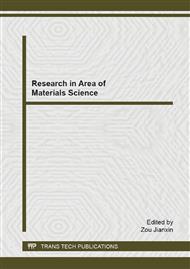[1]
B. O'Regan, M. Grätzel, A low-cost, high-efficiency solar cell based on dye-sensitized colloidal TiO2 films, Nature, 353 (1991), 737-739.
DOI: 10.1038/353737a0
Google Scholar
[2]
Y. H. Numata, S. P. Singh, A. Islam, M. Iwamura, A. Imai, K. Nozaki, L. -Y. Han: You have full text access to this contentEnhanced Light-Harvesting Capability of a Panchromatic Ru(II) Sensitizer Based on π-Extended Terpyridine with a 4-Methylstylryl Group for Dye-Sensitized Solar Cells, Adv. Funct. Mater., 23 (2013).
DOI: 10.1002/adfm.201202504
Google Scholar
[3]
L. Han, A. Islam, H. Chen, C. Malapaka, B. Chiranjeevi, S. Zhang, X. Yang, M. Yanagida, High-efficiency dye-sensitized solar cell with a novel co-adsorbent, Energy Environ. Sci., 5 (2012), 6057-6060.
DOI: 10.1039/c2ee03418b
Google Scholar
[4]
N. Onozawa-Komatsuzaki, M. Yanagida, T. Funaki, K. Kasuga, K. Sayama, H. Sugihara, Near-IR dye-sensitized solar cells using a new type of ruthenium complexes having 2, 6-bis(quinolin-2-yl)pyridine derivatives, Sol. Energy Mater. Sol. Cells, 95 (2011).
DOI: 10.1016/j.solmat.2010.05.003
Google Scholar
[5]
Zhang J, Zhang JZ, Li HB, Wu Y, Geng Y, Su ZM., Rational modifications on champion porphyrin dye using different electron-withdrawing moieties toward high performance dye-sensitized solar cells, Phys. Chem. Chem. Phys., 16 (2014), 24994-25003.
DOI: 10.1039/c4cp03355h
Google Scholar
[6]
M. K. Nazeeruddin, P, Péchy, T. Renouard, S. M. Zakeeruddin, R. Humphry-Baker, P. Comte, P. Liska, L. Cevey, E. Costa, V. Shklover, L. Spiccia, G. B. Deacon, C. A. Bignozzi, M. Grätzel, Engineering of Efficient Panchromatic Sensitizers for Nanocrystalline TiO2-Based Solar Cells, J. Am. Chem. Soc., 123 (2001).
DOI: 10.1021/ja003299u
Google Scholar
[7]
H. J. Snaith, Estimating the Maximum Attainable Efficiency in Dye-Sensitized Solar Cells, : Adv. Funct. Mater., 20 (2010), 13-19.
DOI: 10.1002/adfm.200901476
Google Scholar
[8]
N. Martsinovich, A. Troisi, Theoretical studies of dye-sensitised solar cells: from electronic structure to elementary processes, Energy Environ. Sci. 4 (2011), 4473-4495.
DOI: 10.1039/c1ee01906f
Google Scholar
[9]
M. K. Nazeeruddin, P. Péchy, M. Grätzel, Efficient panchromatic sensitization of nanocrystalline TiO2 films by a black dye based on a trithiocyanato–ruthenium complex, Chem. Commun., 1997 (1997), 1705-1706.
DOI: 10.1039/a703277c
Google Scholar


